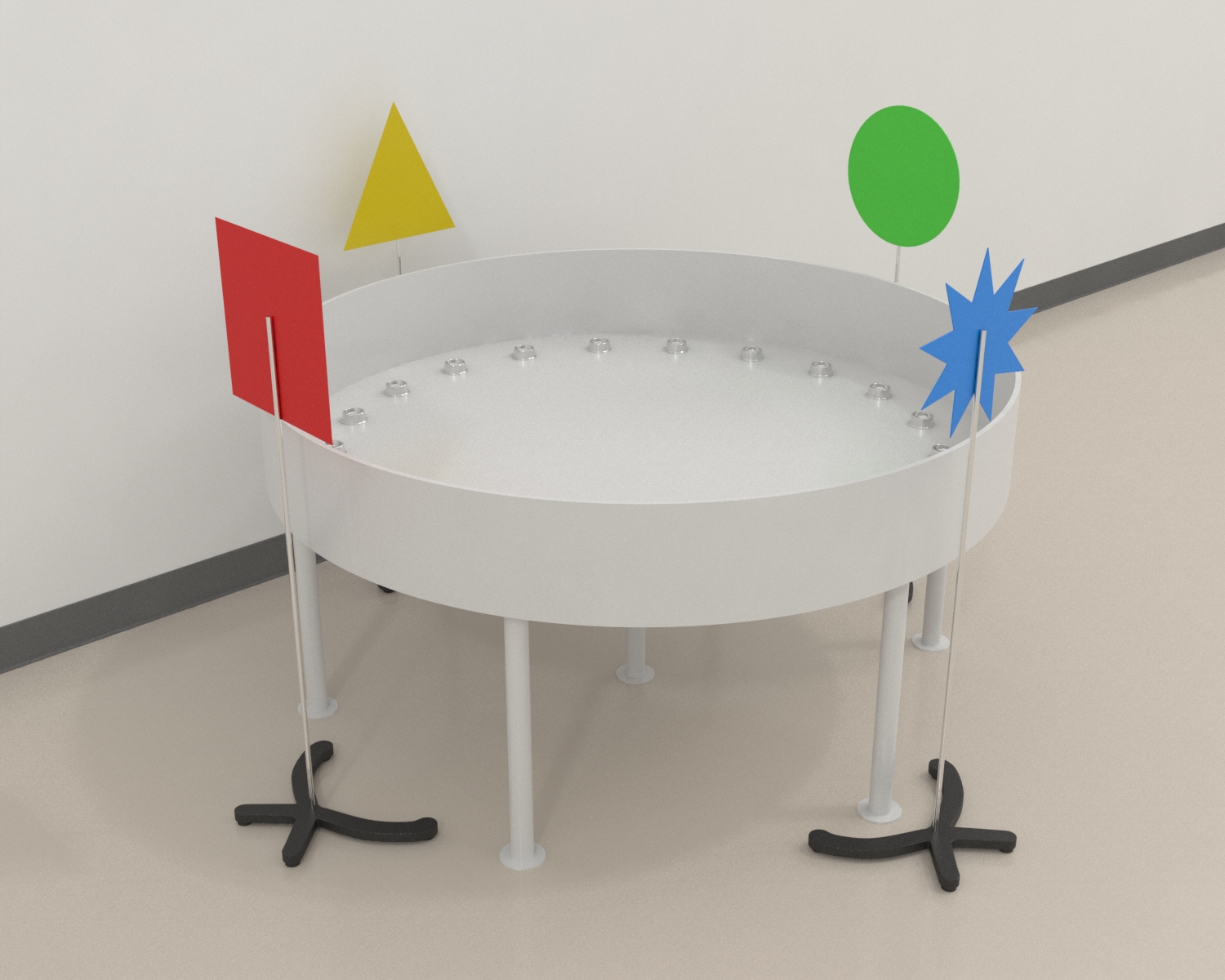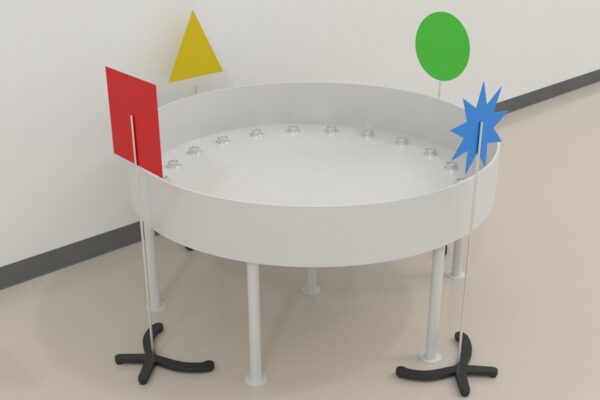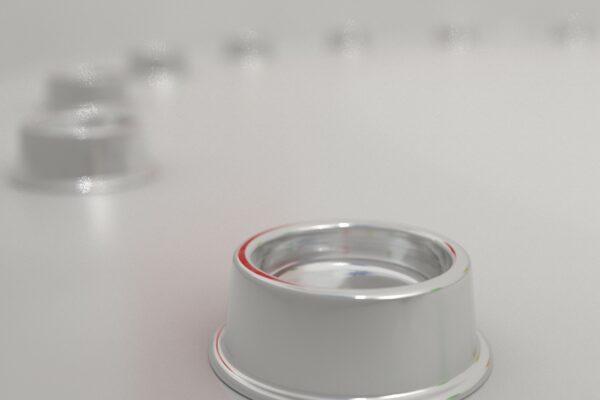The Modified Oasis Maze is a type of water maze that is used in behavioral studies of rodents, particularly mice. It is a variation of the classical circular water maze in which a platform is placed within a pool of opaque water. The maze is modified in that the platform is made of transparent material, allowing the mouse to locate it by seeing the underwater environment. This variation of the water maze is used to study spatial learning and memory, as well as other cognitive and behavioral processes such as attention, motivation, and decision-making. The Modified Oasis Maze provides a more challenging and complex environment than traditional water mazes and has been used to investigate various aspects of brain function in mice.
The modified oasis maze is an “open field” circular arena of 1.4m in diameter. It has a 20cm high wall and is raised 50cm above the floor. The maze board has twenty-one evenly spaced “tight to the board” wells (Dimensions: 2cm height and 4.5cm diameter), which can be baited with water. Noldus EthoVision XT is placed at a zenithal position for video recording and tracking subject behavior within the maze.
Maze Engineers offer the Modified Oasis Maze.
Pricing
4 Ft (Mouse)
$ 1490
Per Month- Polyethylene exterior
- Non cloggable drain placed on side or under. Choice on order.
- 1 Platform included
6 Ft (Rat)
$ 1890
Per Month- Polyethylene exterior
- Non cloggable drain placed on side or under. Choice on order.
- 1 Platform included
Are you an academic scientist and creator?
Learn how your lab can tech transfer this and similar devices from your lab to industry.
Documentation
Introduction
Modified Oasis Maze is a variation of the Dry Morris Water maze, another dry land version of Morris Water Maze. The Modified oasis maze is used to assess the navigational strategies of animals during spatial learning. It can evaluate different parameters (such as latency or path length) of learning, navigation, and animal orientation. Moreover, it can also be used to study the effects of drugs on rodents’ navigation strategies. On the other hand, the Dry Morris Water maze measures rodents’ ability to remember and locate hidden rewards.
Different behavioral tasks are used for spatial learning assessment in animals and rodents, such as Morris Water Maze, Barnes maze, Oasis maze, T-maze, Y maze, and many others. Despite a great variety of spatial learning tasks, the number of behavioral parameters used to evaluate spatial learning is very few. The most widely used parameters are latency or path length. A modified Oasis maze can efficiently measure these parameters. Several other parameters, such as time spent in the maze’s central periphery and turning angle, can also be measured.
Modified Oasis maze is an open-field arena, raised above the floor in an isolated room with constant distal visual cues. It has twenty-one evenly spaced “tight to the board” wells to be baited with water.
The experiment consists of a pre-training phase and a testing phase. In the test phase, the animal enclosed with a black cylinder is placed at a starting point over the arena. Each trial begins when the cylinder is removed and ends after a minute time interval or when the subject has reached the reward. A session of several trials per day is conducted for 4-6 consecutive days. The task results are recorded and subjected to statistical analysis.
Apparatus and Equipment
The modified oasis maze is an “open field” circular arena of 1.4m in diameter. It has a 20cm high wall and is raised 50cm above the floor. The maze board has twenty-one evenly spaced “tight to the board” wells (Dimensions: 2cm height and 4.5cm diameter), which can be baited with water. Noldus EthoVision XT is placed at a zenithal position for video recording and tracking subject behavior within the maze.
Training Protocol
Pre-training
Water-deprive the subject for 24 hours and let it seek for a water drop in the wells. Bait a few wells randomly with water and allow the subject to explore the wells until it can find all the rewards.
Main Task
Enclose the animal in a black cylinder and place it over the arena. To begin the trial, remove the cylinder and let the subject explore the arena. During the 20-30 seconds inter-trial period again, enclose the animal with the cylinder and move it to a new random starting position to prevent the animal’s stereotyped trajectory. Conduct several trials per session, and the time for each trial should be at least 1 minute. On each testing day, remember to shift the reward to a new position to encourage new spatial learning. Clean the maze with ethanol after each session. Record the trajectory of the animal with the video recorder and subject the results to statistical analysis.
Literature Review
Determination of navigation and orientation patterns in rodents
Concha-Miranda et al. (2020) studied how different parameters such as latency or path length, turning angle and straightness, etc. affect navigation and orientation strategies of rodents and contribute to their spatial learning and behavior in the modified oasis maze. Thirty-four adult male Sprague Dawley rats were kept at 12/12-hour light/dark cycle. They were divided into two groups; exercised and impaired. The experiment consisted of two phases, a pre-training phase, and a test phase. In the pre-training phase, the animals were water-deprived for 24 hours and allowed to explore water drop in the maze wells for about 10 minutes on three consecutive days until the animals could find all the rewards in 10 randomly baited wells. In the test phase, the rats were enclosed in a black cylinder (22cm diameter x 27cm height) over the arena. At the beginning of each session, the cylinder was removed, and the rat was allowed to explore the arena for one minute. During the 20-30s inter-trial period, the rat was shifted to a random new position. The animals’ trajectory was recorded using a video recorder. Principal component analysis (PCA) was done to find the effect of different factors on navigation and learning. The animals have then treated with Amyloid β Oligomers (AβO), and their navigation strategies were compared with those of exercised animals. It was concluded that AβO treated animals faced strong orientation difficulties, but the animals with learning enhancement did not.
Studying the impact of Trislocan on hippocampus-dependent spatial memory performance
Arias-Cavieres et al. (2018) studied the impact of Triclosan, a commonly used antiseptic, on the hippocampus’s function. The impact of low concentration of Triclosan on male rat hippocampal slices was observed. Moreover, the effect of intrahippocampal injection of Triclosan on rats’ navigation was determined in a modified oasis maze task. In the experiment, the 23 hours water-deprived Male Sprague Dawley rats (8 to 10 weeks old) were pre-trained for two consecutive days and then subjected to the test phase. In the test phase, which was conducted for six consecutive days (1 session per day and each session with 15 trials), the rats were enclosed in a black cylinder (22cm diameter x 27cm) height over the arena. At the beginning of each session, the cylinder was removed, and the rat was allowed to explore the arena for one minute. During the 20-30s inter-trial period, rats were then shifted to a random new position. The reward was maintained daily in the same location. Two hours after completing the training session on the third day, a group of animals (n=6) was injected with TCS or normal saline, which was repeated later on the same day and the following day. The animals’ trajectory was recorded using a video recorder in a zenithal position. It was concluded that Triclosan exerts highly damaging effects on hippocampal neuronal function.
Data Analysis
- Latency
- Path length
- Turning angle
- Time spent in the center of the periphery of the maze.
- Straightness
- Entropy
Strengths and Limitations
Strengths
The modified oasis maze task is simple and cost-effective. Moreover, apparatus handling is quite easy. The original version of the oasis maze had 400 wells; however, 21 wells modification makes the task easier for the animal to solve. Apart from assessing the navigation and orientation strategies of animals, it also allows us to study the damaging effects of lesions and drugs on hippocampal learning. Furthermore, anxiety-like behavior, common to the open field arena, can be easily detected, analyzed, and controlled in the modified oasis maze task.
Limitations
During the task, the animals might use extra-maze cues to solve the task or develop a stereotyped sequence to reach the target.
Summary
- A modified oasis maze is used to assess animals’ navigation and orientation strategies and different parameters or factors associated with them.
- Modified oasis maze is an open-field arena, placed in an isolated room and has 21 wells baited with water drop.
- During the task, the animal, after pre-training, is subjected to the test phase. The animal is enclosed with a black cylinder over the maze removed at the beginning of the task.
- The effect of different parameters such as latency, path length, turning angle, entropy etc., on navigation, can be evaluated.
References
- Arias-Cavieres, A., More, J., Vicente, J. M., Adasme, T., Hidalgo, J., Valdés, J. L., … & Barrientos, G. (2018). Triclosan impairs hippocampal synaptic plasticity and spatial memory in male rats. Frontiers in molecular neuroscience, 11, 429.
- Concha-Miranda, M., More, J., Grinspun, N., Sanchez, C., Paula-Lima, A., & Valdés, J. L. (2020). Differential navigational strategies during spatial learning in a new modified version of the Oasis maze. Behavioural Brain Research, 112555. DOI: 10.1016/j.bbr.2020.112555.





